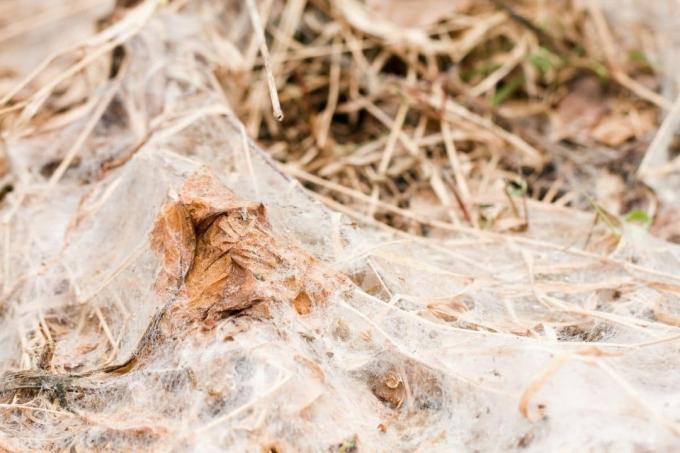
table of contents
- Symptoms and course of the disease
- Fungicides
- Combat
- prevention
- frequently asked Questions
Snow mold (Microdochium nivale) im race is a lawn disease that often occurs between October and March in cold and damp weather. Read our guide to find out what helps against ugly gray-brown spots.
In a nutshell
- no use of fungicides possible
- Combat only by eliminating the cause
- scarify and aerate regularly
- Improve soil permeability through sands
- Refrain from using nitrogenous fertilizers in autumn
Symptoms and course of the disease
You can recognize an infestation with snow mold in the lawn by these symptoms, which usually appear after mild and rainy phases in late winter or spring:
- initially round, brown-gray spots
- greyish-white, cotton wool-like spot with a dark brown border
- get bigger and bigger and merge
- often similar to so-called witch rings
- in spring grasses above ground are mostly dead
- then discolored yellowish brown

As the temperature rises, the gray snow mold (Typhula incarnata) stops growing and heals on its own. Since the grass has only died above ground and the root system is intact, the lawn sprouts again. The characteristic spots are also gradually covered by the regrowing grass.
Fungicides
Basically there are broad-spectrum fungicides that are effective against snow mold in the lawn, such as Ortiva, Saprol or Cueva. However, according to the regulations of the Plant Protection Act, these antifungal agents are not approved for use in home and allotment gardens. So you cannot treat the fungal attack with fungicides.
Tip: Horsetail broth or horsetail broth also helps against fungal infections. a strong garlic and onion infusion that is splashed once a week. However, these are only effective in the early stages or as a preventive measure if the infestation is low.
Combat
To get rid of snow mold in the lawn, you need to get rid of the causes. Therefore, these measures have proven effective:
- Thoroughly comb the affected areas with a hand scarifier
- entire Scarify the lawn
- Aerate the soil
- Spread sand or humus on the lawn and work it in

You should also provide the infested lawn with a potassium-based lawn fertilizer after scarifying and aerating. The nitrogen content should be set lower than normal, as nitrogen-based fertilization promotes fungal growth. It is also better not to lime the lawn, as the pathogen prefers an alkaline pH value in the soil.
Tip: After this extensive treatment, some areas of the lawn should be quite bare. Improve the soil with humus and sand and re-sow the lawn.
prevention
In any case, the fungus disappears all by itself with increasing temperatures. Nevertheless, you must not feel safe, as the disease will certainly come back when the weather is right - humid at 0 to 10 ° C. This is why you should take good care of your lawn to prevent re-infection:
- Scarify and remove thatch twice a year
- aerate in spring
- Remove autumn leaves, also clippings
- no nitrogen-rich fertilizer in the fall
- mow regularly in spring and summer
- do not mow too deep, at least four centimeters

You should also improve the permeability of the soil by sanding the surface after each aeration, for example. With these measures, snow mold will have a hard time coming back.
frequently asked Questions
Snow mold is a lawn disease caused by a fungus. This is always present in the environment, but only spreads in damp, cool weather and at temperatures between 0 and 10 ° C. This means that the characteristic gray-brown and ever-increasing spots occur preferentially in rainy, mild winters and in spring after thawing snow.
The fungal infection also only occurs on weakened lawns that are not adequately ventilated, for example. The causes are therefore lawn thatch, autumn leaves or clippings that have not been cleared. Loamy soils that are poorly permeable to water are also conducive to infestation because they remain moist for a long time. Another common cause is nitrogen fertilization with only a small amount of potassium.
Occasionally, after a snowy winter, you can read in local newspapers that public lawns and sports fields with natural grass are closed due to snow mold infestation. The reason for this is not, as is sometimes assumed, that the fungus is also dangerous for humans, but because the fungal spores can be transferred to healthy lawns via the soles of shoes. So if you step onto a lawn infected with snow mold, you should then thoroughly clean and disinfect your shoes.

